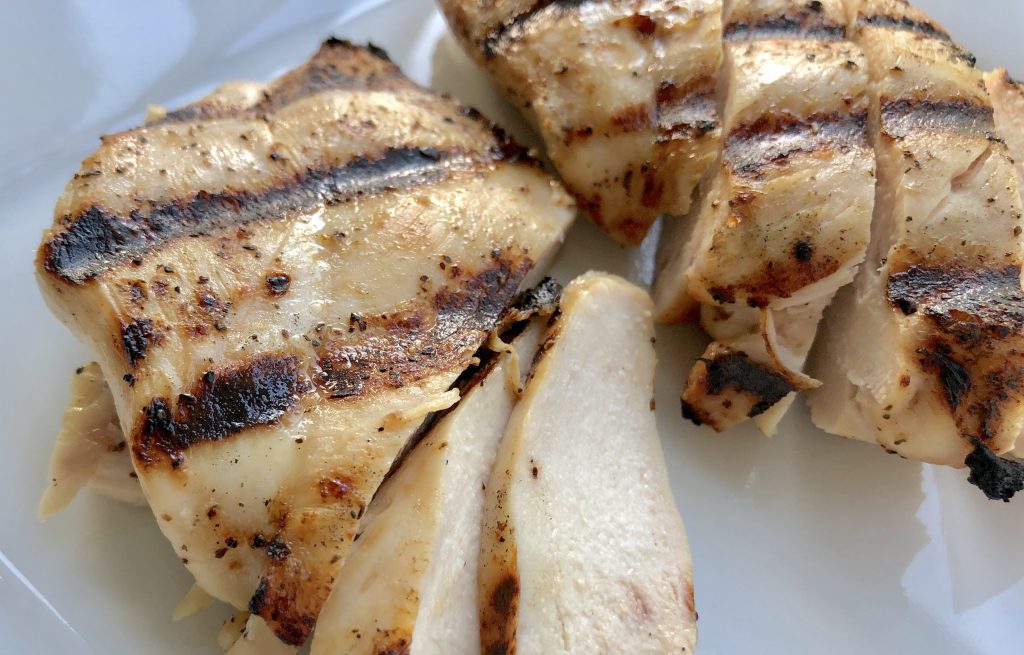Ever wonder how restaurants serve up those perfectly grilled chicken breasts that are moist and tender on the inside, yet have gorgeous grill marks on the outside? That’s exactly what we’re aiming for with this recipe! Forget about dry, stringy chicken that’s charred on the outside and bland in the middle. With a few key techniques, you’ll get delicious grilled chicken every single time.
Why Homemade Chicken Turns Out Dry
One of the biggest culprits for overcooked and dry chicken at home is fear of undercooking. Many home cooks tend to leave chicken on the grill for too long, worried about salmonella. While I always recommend cooking chicken to the USDA-recommended safe temperature of 165°F (no lower!), it’s important to pull it off the grill as soon as it reaches this point. Cooking beyond 165°F leads to fibers shrinking and squeezing out all the moisture, no matter what cooking method you use.
Tips for Perfect Grilled Chicken Every Time
- Optional: Brine for Extra Moisture
Brining can add extra moisture and flavor. I use a dry brine method. - Pound to an Even Thickness
This step is crucial. Uneven cooking is the main reason chicken breast turns out dry. By pounding the chicken to a uniform thickness, you ensure that it cooks evenly, preventing the thinner parts from becoming overcooked while waiting for the thicker parts to finish. - Season Generously
Don’t skimp on seasoning. A well-seasoned chicken breast makes all the difference, so add salt, pepper, and any other spices you love before grilling. - High Heat is Your Friend
High heat is key to achieving a nice sear and retaining moisture. Cook the chicken breasts over high heat, and aim for a quick cooking time. With an even thickness, this should take no more than 10 minutes—so don’t walk away from the grill! - Use a Thermometer
Remove the chicken from the grill as soon as it hits 165°F. If you’re unsure, pull it off a few degrees early, as the internal temperature will continue to rise slightly during resting. Insert the thermometer into the side of the chicken, not the top, for the most accurate reading. - Let it Rest
Allow the chicken to rest for at least 5 minutes before slicing. This helps redistribute the juices, making each bite tender and juicy.
Final Thoughts
Even without brining, this method yields consistently moist, perfectly cooked chicken every time. And although I’m not a professional photographer, I can confidently capture just how juicy and melt-in-your-mouth this grilled chicken breast turns out! Say goodbye to dry, bland chicken, and hello to a new go-to recipe for salads, grain bowls, or main dishes.
Try it out, and let me know how it turns out for you. It’s time to leave dry, overcooked chicken in the past!

No more chicken that’s completely overcooked and overly charred on the outside before the inside is cooked, under seasoned, missing good grill marks or is completely dry and stringy. I suspect, that by far, the main reason for it is that the chicken is grossly overcooked at home out of fear of salmonella poisoning. Some (many, actually) celebrity chefs advocate cooking chicken breasts to 150-155 temperature. I definitely do not agree with that and believe that chicken should be cooked to the safe government suggested temperature of 165. But not more! As you cook your chicken breast, the fibers shrink and squeeze out the moisture. It doesn’t matter if you baste it, cover it or use any other incorrect techniques. The moisture will keep evaporating and dry out your meat. So as your chicken cooks past 165 it now becomes a matter of just how stringy and dried out it will become.
So here are a few tips for great grilled chicken:
- Brining chicken breast is not a bad idea, but is totally optional. I have to admin, however, that this adds an extra step to this very simple and quick dish and for this reason I almost always skip it.
- Pounding chicken to even thickness is a must. To me this is not an optional step. Uneven cooking is by far the biggest culprit when it comes to grilled chicken breast. Think about the thickness differential between the chicken – it may be 1/2″ thick on one end and close to 2″ thick on the other end. By the time the thick end cooks, the outside and the thin part of the chicken will be grossly overcooked.
- Season the chicken well. To avoid bland tasting chicken.
- It’s all about high heat. Pound to an even thickness + Cook as quickly as possible over high heat = maximum moisture retention.
- Do not overcook. Every recipe says that but what does it mean to someone who doesn’t really cook that many chicken breasts. Remove the chicken breast as soon as it reaches your target safe internal temperature (or maybe even a few degrees earlier as the temperature will still rise during resting.) I’ve seen way too many chicken breasts cooked to 180 and above. There’s absolutely no reason for that – 180 is not safer than 165 ( with 165 being an instant kill zone.) It’s very unlikely that pounded chicken breast will take more than 10 minutes, so do not walk away! Use a thermometer and measure correctly by inserting it into the middle from the side of the chicken to avoid incorrect measurement.
- Let the chicken rest. For at least 5 minutes, then slice it up and enjoy!
And although, as I said before, I don’t likely photography and possibly don’t always pick the best angle or light – I can still capture just how juicy, melt in your mouth this chicken breasts is Every Single Time! No more dry, stringy grilled chicken breast!

Place one chicken breast at a time in a resealable plastic bag or between couple of layers of plastic wrap. Cover with a paper towel to catch the splatter just in case. Pound lightly to an even thickness with a flat side of a meat mallet (rolling pin or a bottom of a frying pan will also work;) you will basically gently pound the side of the chicken breast that's thicker - that's it! Don't pound too thin, we are not making a schnitzel here. The goal here is to even out the chicken breasts, so it's more or less the same thickness (a bit of difference is fine.) I usually go for at least 3/4" thickness. But anywhere between 1/2 - 3/4" thickness will work, just as long as you remember that thinner chicken will cook faster.
Season your chicken breasts with salt an pepper. If you have time, refrigerate them uncovered after they are seasoned for 1-4 hours to "dry brine" them. Brush the chicken lightly with oil.
Preheat your grill to high by turning all the burners, but one, to medium-high. Make sure to clean and oil your grill.
The reason one burner is off, is that just in case any specific piece of chicken gets too charred, it can finish cooking over the indirect heat. However, this is unlikely with this technique, when the chicken is pounded and cooked on a gas grill.
Place your chicken directly over medium-high heat and cook undisturbed for 4-5minutes. The goal is to get very nice grill marks without burning the chicken, while cooking the chicken more than halfway.
Flip the chicken over and finish cooking on the other side for 2-5 minutes until the safe internal temperature of 165F is reached. Your chicken is already cooked more than half of the way, so the other side, depending on how thick your chicken breast was may only take a couple of minutes.
Insert the thermometer carefully into the middle of the breast from the side of the chicken to get an accurate measure. The second it hits 165 in the middle of the breast, remove the chicken from heat and let it rest.
After at least 5 minutes of rest time, slice it up against the grain of the chicken and enjoy.
Feel free to drizzle your chicken with olive oil, lemon juice and crushed garlic mixture.
Ingredients
Directions
Place one chicken breast at a time in a resealable plastic bag or between couple of layers of plastic wrap. Cover with a paper towel to catch the splatter just in case. Pound lightly to an even thickness with a flat side of a meat mallet (rolling pin or a bottom of a frying pan will also work;) you will basically gently pound the side of the chicken breast that's thicker - that's it! Don't pound too thin, we are not making a schnitzel here. The goal here is to even out the chicken breasts, so it's more or less the same thickness (a bit of difference is fine.) I usually go for at least 3/4" thickness. But anywhere between 1/2 - 3/4" thickness will work, just as long as you remember that thinner chicken will cook faster.
Season your chicken breasts with salt an pepper. If you have time, refrigerate them uncovered after they are seasoned for 1-4 hours to "dry brine" them. Brush the chicken lightly with oil.
Preheat your grill to high by turning all the burners, but one, to medium-high. Make sure to clean and oil your grill.
The reason one burner is off, is that just in case any specific piece of chicken gets too charred, it can finish cooking over the indirect heat. However, this is unlikely with this technique, when the chicken is pounded and cooked on a gas grill.
Place your chicken directly over medium-high heat and cook undisturbed for 4-5minutes. The goal is to get very nice grill marks without burning the chicken, while cooking the chicken more than halfway.
Flip the chicken over and finish cooking on the other side for 2-5 minutes until the safe internal temperature of 165F is reached. Your chicken is already cooked more than half of the way, so the other side, depending on how thick your chicken breast was may only take a couple of minutes.
Insert the thermometer carefully into the middle of the breast from the side of the chicken to get an accurate measure. The second it hits 165 in the middle of the breast, remove the chicken from heat and let it rest.
After at least 5 minutes of rest time, slice it up against the grain of the chicken and enjoy.
Feel free to drizzle your chicken with olive oil, lemon juice and crushed garlic mixture.










